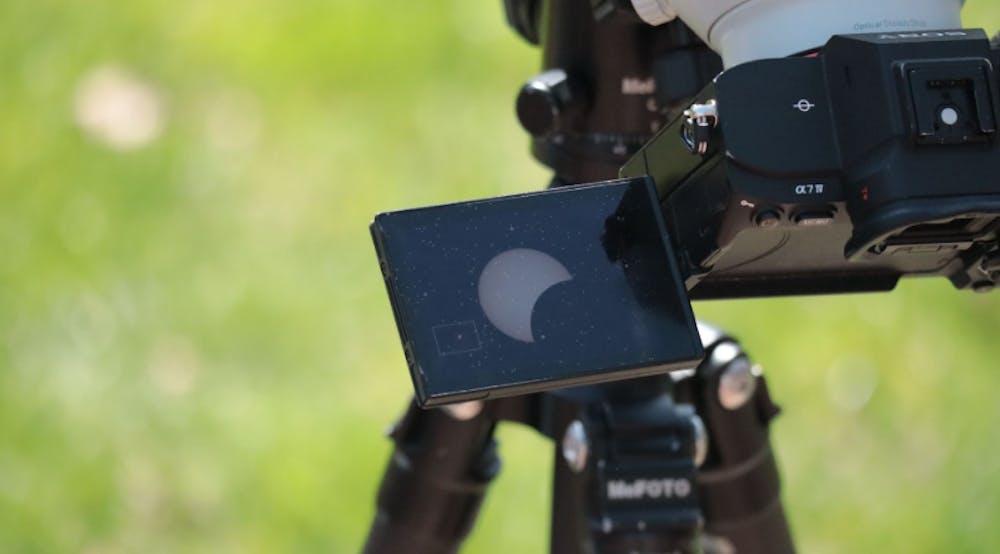A near-total solar eclipse cast a shade over the University of Richmond on the afternoon of April 8.
Through protective glasses or telescopes, which were required to ensure a safe viewing experience, the moon and the sun’s alignment at partial coverage looked almost like a misaligned slide seen through a microscope.
The eclipse lasted from roughly 2 p.m. to 4:30 p.m. in Richmond with peak coverage at 3:17 p.m. Students gathered outside all around campus, primarily in the Forum for the watch party hosted by the Society of Physics Students and at the International Center for a viewing hosted by the geography department. Some students skipped a part of their class to see the peak coverage, while others went outside with their entire class in addition to faculty and staff.
“It’s a once-in-a-20-year opportunity,” said associate professor of economics Saif Mehkari. “They’ve already run out of glasses.”
First-year Dylan Javier said that this was his first time seeing an eclipse in person.
“When I came out, my big fear was that I wouldn’t get to see it because of my lab, but then we got out,” Javier said. “This time I nearly didn’t see it because we had so many people who wanted to see it. This cool event that doesn’t happen very often. That’s kind of why I was interested in seeing it.”
Solar eclipses occur every one to three years somewhere around the globe, according to a CBS News article, but they are typically only visible from locations that cannot be easily accessed, such as the North and South Poles or the middle of the ocean. The most recent solar eclipse prior to the one seen Monday was in 2021, but it could only be seen from Antarctica. The last visible total solar eclipse from the U.S. was on Aug. 7, 2017, and the one before that was on Feb. 26, 1979.
Starting from the 19th century, Richmond has been reported to have witnessed a number of eclipses. According to an article by The Richmond Times-Dispatch, an eclipse on March 7, 1970 came as close to having a 98% coverage.
Despite not being on the path of totality, which ran through the United States starting at Kerrville, Texas and swooped its way northeast, Virginia saw about 83% in the moon’s coverage of the sun this year, according to NASA's Eclipse Explorer. Northern and southwest areas of Virginia saw up to 90% coverage. Compared to the last solar eclipse in 2017, this eclipse had a wider traveling path, longer time in totality, and the sun at a more magnetically asymmetrical state, which made it possible to see streamers–which are cap-like structures with pointed peaks–throughout its corona or outer atmosphere.
The phenomenon also offers scientists a unique opportunity to study the sun, moon, and Earth in different ways. According to a recent NASA news conference, a solar eclipse allows the agency to collect data about the sun’s corona that otherwise would be difficult to obtain.
NASA predicts that the next total solar eclipse visible in the U.S. will not be until 2045.
“I’m very excited,” said David Hu, a first-year majoring in physics and math. “I want to skip to [2045].”
Enjoy what you're reading?
Signup for our newsletter
Support independent student media
You can make a tax-deductible donation by clicking the button below, which takes you to our secure PayPal account. The page is set up to receive contributions in whatever amount you designate. We look forward to using the money we raise to further our mission of providing honest and accurate information to students, faculty, staff, alumni and others in the general public.
Donate Now



